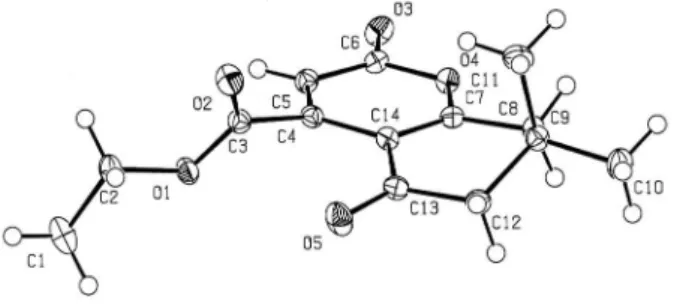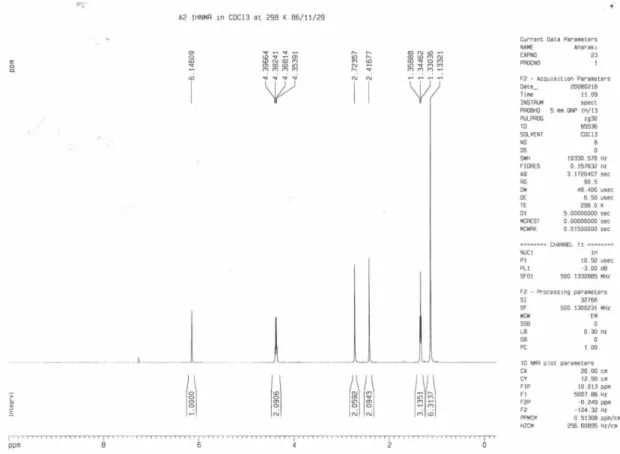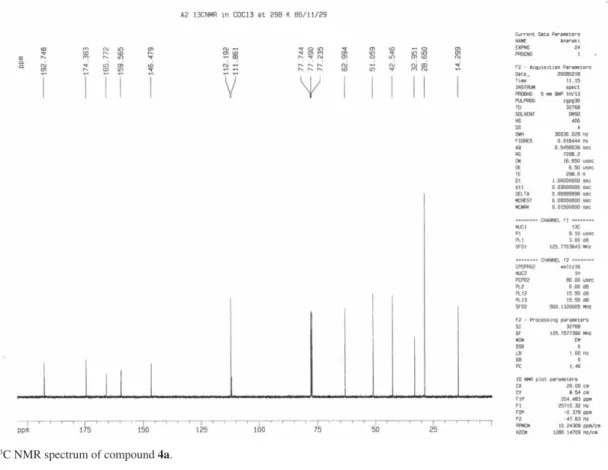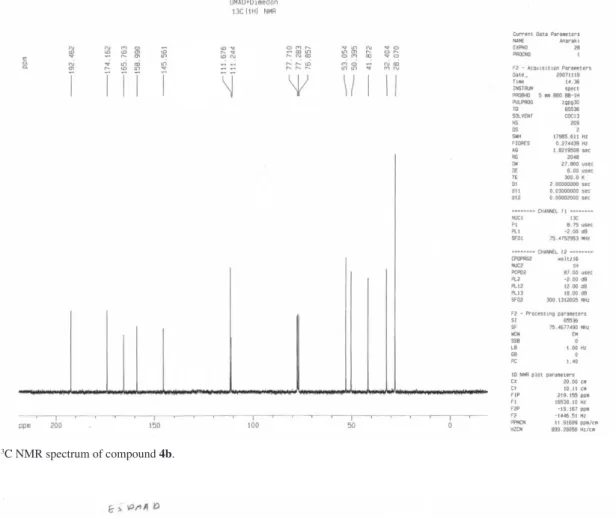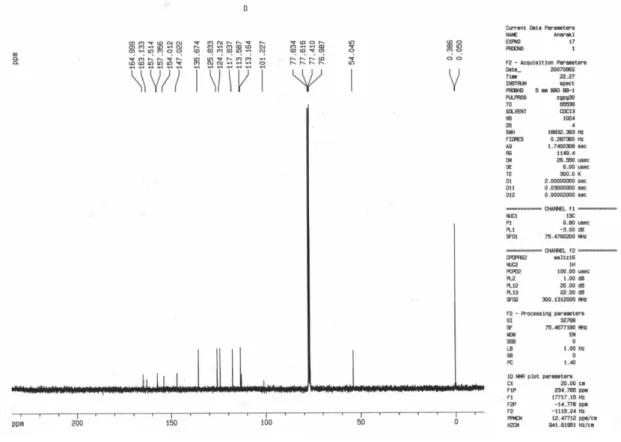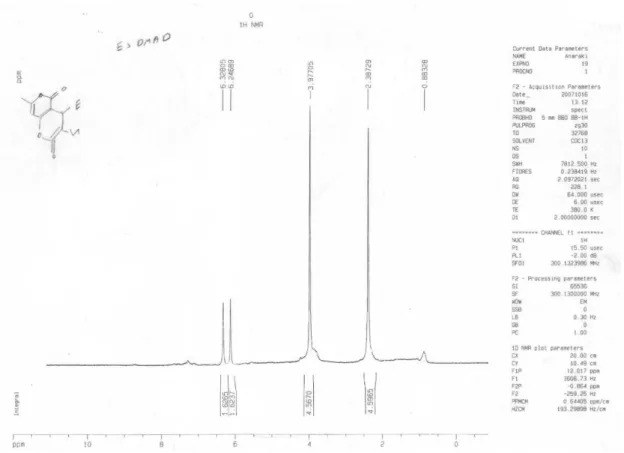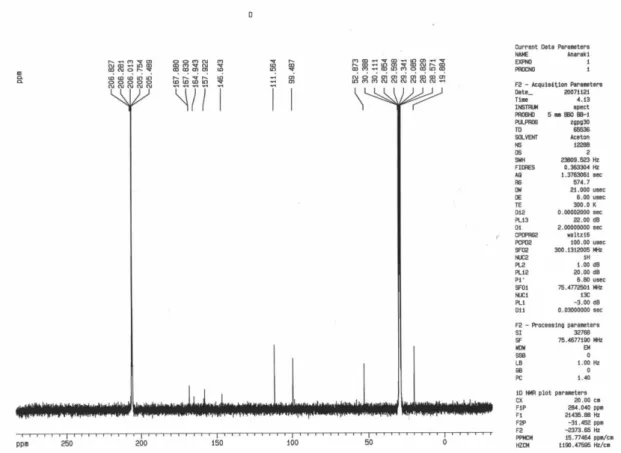Article
J. Braz. Chem. Soc., Vol. 21, No. 2, 319-323, 2010. Printed in Brazil - ©2010 Sociedade Brasileira de Química 0103 - 5053 $6.00+0.00
*e-mail: mohammadanary@yahoo.com
Isoquinoline-Catalyzed Reaction between 4-Hydroxycoumarin or
4-Hydroxy-6-methylpyran-1-one and Dialkyl Acetylene Dicarboxylates:
Synthesis of Coumarin and Pyranopyrane Derivatives
Mohammad Anary-Abbasinejad,*,a Hossein Anaraki-Ardakani,a
Mohammad Hossein Mosslemina and Hamid Reza Khavasib
aDepartment of Chemistry, Islamic Azad University, Yazd Branch, PO Box 89195-155, Yazd, Iran
bDepartment of Chemistry, Shahid Beheshti University, PO Box 1983963113, Tehran, Iran
Neste trabalho, relatamos a reação entre dialquil acetilenodicarboxilatos e sistemas enólicos tais como 5,5-dimetil-1,3-ciclohexanodiona, 1,3-ciclohexanodiona, 4-hidroxicumarina ou 4-hidróxi-6-metilpiran-1-ona na presença de isoquinolina, a qual leva a novos derivados de cumarina e piranopirano.
In this work we report the reaction between dialkyl acetylenedicarboxylates and enolic systems such as 5,5-dimethyl-1,3-cyclohexanedione, 1,3-cyclohexanedione, 4-hydroxycoumarin or 4-hydroxy-6-methylpyran-1-one in the presence of isoquinoline, which leads to new coumarin and pyranopyran derivatives.
Keywords: acetylenedicarboxylic esters, isoquinoline, pyranopyran derivatives, coumarin derivatives
Introduction
Coumarin is the structural motif of many natural and synthetic compounds that endows them with a wide range of biological activities. Given the development of coumarins as photosensitizers,1 anti-HIV agents,2 antibiotics,3 rodenticides, and oral anticoagulants,4 there is continuing interest in the synthesis of these materials.
The rich and fascinating chemistry stems from the addition of nucleophiles to activated acetylene compounds has evoked considerable interest. N-Heterocycles are
known to form zwitterions with activated acetylene compounds such as dimethyl acetylenedicarboxylate.5-11 These zwitterions intermediate can be trapped with a variety of electrophiles and proton donors, which is a novel protocol for the synthesis of heterocyclic compounds.5-13 Trapping of the zwitterion formed by the addition of isoquinoline to dimethyl acetylenedicarboxylate (DMAD) with electrophiles such as isocyanates,14N-tosylimines,15 quinines16 and electrophilic styrenes,17 has been recently used for the synthesis of different isoquinoline-fuzed heterocyclic systems. Reaction of electron-deficient
acetylene esters with isoquinoline or quinoline has been also studied in the presence of organic acidic compounds. Reaction of quinoline-DMAD zwitterion with C-H acidic compound indan-1, 3-dione was reported to afford pyrroloquinoline derivatives.18 Isoquinoline-DMAD zwitterion was also reported to react with N-H acidic compounds such as pyrrole, indole19 and amides20 to afford substituted dihydroisoquinoline derivatives. In view of our interest in multicomponent reactions of nucleophiles with activated acetylenes and organic acidic compounds,21-23 we wish to report herein the results of our studies on the reaction of isoquinoline with acetylenedicarboxylic esters in the presence of O-H acidic compounds such as 5,5-dimethyl-1,3-cyclohexanedione (Dimedone), 1,3-cyclohexanedione, 4-hydroxycoumarin or 4-hydroxy-6-methylpyran-1-one.
Results and Discussion
In an initial experiment, the reaction of diethyl acetylenedicarboxylate (DEAD, 1) with dimedone (2)
in the presence of isoquinoline (3) in dichloromethane
Isoquinoline-Catalyzed Reaction between 4-Hydroxycoumarin or 4-Hydroxy-6-methylpyran-1-one J. Braz. Chem. Soc. 320
The product was characterized on the basis of spectroscopic data. In the 1H NMR spectrum the two methylene groups was observed at d 2.41 and 2.72 ppm as two single signals. The resonance signals due to the two ethoxycarbonyl groups appeared as a triplet at d 1.34 (J 7.2 Hz) and a quartet
at d 4.38 (J 7.2 Hz), supporting the IR absorption at 1726
cm-1. A singlet was observed at d 1.33 for the two methyl groups. The oleinic proton appeared at d 6.14 ppm as a singlet. In the 13C NMR spectrum twelve distinct signals were observed, which is consistent with the proposed structure. The structure and regiochemistry of compound
4a was unambiguously established by single crystal
X-ray analysis (Figure 1). The distinction between γ- and
d-lactonization products 3 and 4 was based on the X-ray
crystallographic data. As shown in Scheme 1, the reaction was found to be applicable to DMAD. The spectral data for compound 4b were very similar to compound 4a, with
exceptions of the signals due to the alkoxycarbonyl groups.
A reasonable mechanism for the formation of compound 4a is illustrated in Scheme 2. The zwitterion,
formed from isoquinoline and DEAD (2) was protonated
with dimedone to afford the cation 6 and the enolate ion 7. The anion 7 then underwent Michael addition to cation 6 to furnish the zwitterion 8, which was transformed into
another zwitterion by an intramolecular proton transfer. Zwitterion intermediate 9 underwent lactonization to
produce cation 10 and ethoxide anion. Finally, ethoxide
anion absorbed a proton from the cation 10 and promoted
the elimination of isoquinoline to furnish the product 4a.
Under similar conditions, the reaction of isoquinoline with DMAD and 4-hydroxycoumarin (11) led to methyl
2,5-dihydro-2,5-dioxopyrano[3,2-c]chromene-4-carboxylate
12a in 90% yield (Scheme 3). In the 1H NMR spectrum of
compound 12a methoxy group was observed at d 4.02 ppm as a single signal. A singlet was observed at d6.41 for the oleinic proton. The aromatic protons appeared at d 6.27-8.12 ppm. In the 13C NMR spectrum fourteen distinct signals were observed, which is consistent with the proposed structure.
As shown in Scheme 3, similar product 12b was
obtained when DEAD was used as the activated acetylene. However, treatment of ditertiobutyl acetylenedicarboxylate (DTAD, 2c) with isoquinoline and 4-hydroxycoumarin
(11), and separation of the reaction mixture by column
chromatography afforded di-tert-butyl 2-(4-hydroxy-2-oxo-2H-chromen-3-yl)fumarate13 in 95% yield (Scheme 4). Scheme 1. Reaction between acetylenedicarboxylates and dimedone
or1,3-cyclohexandione in the presence of isoquinoline.
Figure 1. ORTEP representation of 4a.
Anary-Abbasinejad et al. 321 Vol. 21, No. 2, 2010
The 1H NMR spectrum of compound 13 exhibited two sharp single signals at d 1.43 and 1.52 ppm for two t-butyl
groups. The oleinic proton appeared at d 6.91 ppm as a singlet. A broad singlet was observed for O-H proton (removed by addition of D2O) at d 10.35 ppm. Aromatic protons were observed at d 7.28-8.00 ppm. 13C NMR spectrum showed sixteen resonances in agreement with the proposed structure.
The reaction of isoquinoline-DMAD zwitterion was also carried out towards 4-hydroxy-6-methylpyran-1-one (14) and methyl 2, 5-dihydro-7-methyl-2, 5-dioxopyrano
[4, 3-b] pyran-4-carboxylate 15 was obtained in 90%
yield (Scheme 5). The 1H NMR spectrum of compound
15 exhibited four sharp single signals at d 2.38 (3 H), 3.97 (3 H), 6.24 (1 H) and 6.33 (1 H) for two methyl and two methine protons. 13C NMR spectrum showed ten distinct resonances in agreement with the proposed structure.
Conclusions
From the above results, we conclude that treatment of enolic systems such as dimedone, 4-hydroxycoumarin or 4-hydroxy-6-methylpyran-1-one with acetylene-dicarboxylates and isoquinoline can lead to the formation of some fused heterocycles. The whole reaction can be
considered as an addition reaction between acetylene derivative and enolic system, followed by a d-lactonization one, catalized by isoquinoline. The presented method has the advantage of being performed under neutral conditions and requires no activation or modiication of the reagents.
Experimental
Melting points were determined with an electrothermal 9100 apparatus. Elemental analyses were performed using a Heraeus CHN-O-Rapid analyzer. Mass spectra were recorded on a Finnigan- MAT (San Jose, CA, USA) 8430 mass spectrometer operating at 70 eV. IR spectra were recorded on a Shimadzu (Tokyo, Japan) IR-470 spectrometer. 1H and 13C NMR spectra were recorded on BRUKER DRX-300 AVANCE spectrometer at 300.1 and 75.46 MHz, respectively. 1H and 13C NMR spectra were obtained on solution in CDCl3 using TMS as internal standard. The chemicals used in this work were purchased from Fluka (Buchs, Switzerland) and were used without further puriication.
General procedure
To a magnetically stirred solution of the enolizable compound (1 mmol) and isoquinoline (1 mmol) in 10 mL acetone was added dropwise a mixture of acetylenedicarboxylates (1 mmol) in 5 mL acetone at room temperature. The reaction mixture was then stirred for 24 h. The solvent was removed under reduced pressure and the residue was puriied by silica gel column chromatography using hexane-ethyl acetate as eluent to afford the pure title compounds.
Ethyl 5,6,7,8-tetrahydro-7,7-dimethyl-2,5-dioxo-2H-chromene -4-carboxylate (4a)
Colorless crystals; yield 0.25 g (95%), mp 96-98 °C; IR(KBr) νmax/cm-1: 1760, 1733 (C=O). MS (m/z, %): 264 (M+, 8). 1H NMR (300.1 MHz, CDCl
3): d 1.13 (6 H, s, 2 CH3), 1.34 (3 H, t,3J
HH 7.2 Hz, OCH2CH3), 2.41, 2.72 (4H, 2s, 2CH2), 4.38 (2H, q, 3J
HH 7.2 Hz, OCH2CH3,), 6.14 (1H, s, CH) ppm. 13C NMR (75.46 MHz, CDCl
3): d 14.29 (OCH2CH3), 28.65 (2Me), 32.95 (C (Me) 2), 42.54, 51.09,
(2CH2) 62.99 (OCH2CH3), 111.86 (CH), 112.19(O-C=C),
146.47(C-CO2Et), 159.56(O-C=C), 165.77, 174.38, 192.74
(3C=O) ppm. Anal.Calc. for C14H16O5: C, 63.63; H, 6.10%. Found: C, 63.81; H, 5.9%.
Crystal data for 4a
Formula (C14 H16 O5): Fw = 264.27, trigonal, space group R-3, crystal dimensions 0.50 × 0.49 × 0.45 mm,
Scheme 3. Reaction between acetylenedicarboxylates and
4-hydroxycoumarin in the presence of isoquinoline.
Scheme 4. Reaction between ditertiobutyl acetylenedicarboxylate and 4-hydroxycoumarin in the presence of isoquinoline.
Scheme 5. Reaction between dimethyl acetylenedicarboxylate and
Isoquinoline-Catalyzed Reaction between 4-Hydroxycoumarin or 4-Hydroxy-6-methylpyran-1-one J. Braz. Chem. Soc. 322
a = 22.5641(18) Å , b = 22.5641(18) Å , c = 13.2610(13) Å,
α = 90 deg, β = 90 deg, γ = 120 deg. V = 5847.1(9) Å 3, Z = 18, Dcalc. = 1.351 mg m-3, 1.86°< θ < 29.12°, F(000) = 2520; section of the reciprocal lattice: −19 ≤ h ≤ 30, −30 ≤ k ≤ 26,
−14 ≤ l ≤ 18; of the 6231 relections that were collected, 3384 were unique with I > 2σ(I); absorption coeficient 0.103 mm-1. R1 = 0.0398 for I > 2σ(I) and wR2 = 0.0993; largest peak (0.380 e Å-3) and hole (−0.185 e Å-3).
Crystal data analyses: Stoe IPDSII two-circle diffractometer, MoKa radiation (λ = 0.71073 Å), T = 120(2) K, graphite monochromator; numerical absorption correction. Structure solution by direct methods using SHELXS and reinement by full-matrix least-squares on F2 using SHELXL of the X-STEP32 suite of programs,24 all non-hydrogen atoms were reined anisotropically.
The crystallographic data of 4a have been deposited
with the Cambridge Crystallographic Data Centre as supplementary publication number CCDC-706464. Copies of the data can be obtained free of charge (http://www.ccdc. cam.ac.uk/ data_reques/cif, e-mail: data_request@ccdc. cam.ac.uk, or fax: +44-1223-336033).
Methyl 5,6,7,8-tetrahydro-7,7-dimethyl-2,5-dioxo-2H-chromene-4-carboxylate (4b)
Colorless crystals; yield 0.25 g (95%), mp 96-98 °C; IR(KBr) νmax/cm-1: 1741, 1679(C=O). MS (m/z, %): 250 (M+, 10). 1H NMR (300.1 MHz, CDCl
3): d 1.19 (6 H, s, 2CH3), 2.46, 2.86 (4H,2s,2CH2), 3.85 (3H,s,OCH3), 6.25
(1H,s,CH) ppm. 13C NMR (75.46 MHz, CDCl
3): d 28.07 (2Me), 32.40 (C(Me)2), 41.87, 50.39, (2CH2) 53.05 (OCH3),
111.24 (CH), 111.67 (O-C=C), 145.56 (C-CO2Me), 158.99
(O-C=C), 165.76, 174.16, 192.46(3C=O) ppm. Anal.Calc.
for C13H14O5: C, 62.39; H, 5.64%. Found: C, 62.42; H, 5.73%.
Methyl 5,6,7,8-tetrahydro-2,5-dioxo-2H-chromene-4-carboxylate (4c)
Colorless oil; yield 0.19 g (90%). IR(KBr) νmax/cm-1: 1739, 1672 (C=O). MS (m/z, %): 222 (M+, 8). 1H NMR
(300.1 MHz, CDCl3): d 2.21 (2H, m, CH2), 2.61 (2H,t, CH2, 3J
HH 6.3 Hz), 2.92 (2H, t, CH2, 3JHH 6.3 Hz), 3.97 (3H, s, OCH3), 6.23 (1H, s, CH) ppm. 13C NMR (75.46 MHz, CDCl3): d 19.87, 28.55 and 36.53 (3CH2), 53.24 (OCH3),
112.16 (CH), 112.45 (O–C=C), 145.92(C–CO2Me), 158.78
(O–C=C), 165.9, 175.55, 192.42 (3C=O) ppm. Anal.Calc. for
C11H10O5: C, 59.46; H, 4.54%. Found: C, 59.52; H, 4.41%.
Ethyl 5,6,7,8-tetrahydro-2,5-dioxo-2H-chromene-4-carboxylate(4d)
Colorless oil; yield 0.20 g (85%). IR(KBr) νmax/cm-1: 1760, 1686 (C=O), MS (m/z, %): 236 (M+, 15). 1H NMR (300.1 MHz,
CDCl3): d 1.37 (3H, t, 3J
HH 7.3 Hz, OCH2CH3), 2.18 (2H, m, CH2), 2.59 (2H, t, CH2, 3J
HH 6.3 Hz), 2.89 (2H, t, CH2, 3JHH 6.3 Hz), 4.40 (2H,q, 3J
HH 7.3 Hz, OCH2CH3), 6.17 (1H, s, CH) ppm.
13C NMR (75.46 MHz, CDCl
3): d 13.86 (OCH2CH3), 19.87, 28.54 and 36.52 (3CH2), 62.55 (OCH2CH3), 111.91 (CH),
112.43(O–C=C), 146.32 (C-CO2Et), 158.87 (O–C=C),
165.41, 175.46, 192.43 (3C=O) ppm. Anal.Calc. for C12H12O5: C, 61.01; H, 5.12%. Found: C, 61.18; H, 5.28%.
Methyl 2,5-dihydro-2,5-dioxopyrano[3,2-c]chromene-4-carboxylate (12a)
Colorless crystals; yield 0.24 g (90%), mp 191 °C dec.; IR(KBr) νmax/cm-1: 1758, 1715(C=O). MS (m/z, %): 272 (M+, 6). 1H NMR (300.1 MHz, CDCl
3): d 4.02 (3H, s, OCH3), 6.41(1H, s, CH), 7.42-8.12 (4H, m, arom) ppm. 13C NMR (75.46 MHz, CDCl3): d 54.04(OCH3), 101.22(CH),
113.16, 113.58, 117.83, 124.31, 125.83, 135.67, 147.02, 154.01, 157.35 (c, arom), 157.51, 163.13, 164.99 (3C=O) ppm. Anal.Calc. for C14H8O6: C, 61.77; H, 2.96%. Found: C, 61.89; H, 2.81%.
Ethyl 2,5-dihydro-2,5-dioxopyrano[3,2-c]chromene-4-carboxylate (12b)
Colorless crystals; yield 0.25 g (90%), mp 180 °C dec.; IR(KBr) νmax/cm-1: 1739, 1726(C=O). MS (m/z, %): 286 (M+, 5). 1H NMR (300.1 MHz, CDCl
3): d 1.42 (3H, t,3JHH 7.2 Hz, OCH2CH3), 4.49 (2H, q, 3J
HH 7.2 Hz, OCH2CH3,), 6.40(1H, s, CH), 7.42-8.12 (4H, m, arom) ppm. 13C NMR (75.46 MHz, CDCl3): d 13.69 (OCH2CH3), 62.53
(OCH2CH3), 102.11(CH), 113.41, 113.63, 117.51, 124.04,
125.70, 135.43, 147.27, 154.04, 157.22 (c, arom), 157.60, 162.74, 164.39 (3C=O) ppm. Anal. Calc. for C15H10O6: C, 62.94; H, 3.52%. Found: C, 62.83; H, 3.61%.
Ditertbutyl 2-(4-hydroxy-2-oxo-2H-chromen-3-yl)fumarate (13)
Colorless crystals; yield 0.36 g (95%), mp 72-73 °C; IR(KBr) νmax/cm-1: 1712, 1660(C=O). MS (m/z, %): 388 (M+, 7). 1H NMR (300.1 MHz, CDCl
3): d 1.43, 1.52 (18H, 2s, 2t-Bu), 6.91(1H, s, CH), 7.28-8.00 (4H arom), 10.35(1H, broad singlet,OH) ppm. 13C NMR (75.46 MHz, CDCl3): d 29.72 (2C (CH3)3), 83.61, 84.33 (2C (CH3)3),
101.96, 116.40, 116.43, 124.08, 124.48, 132.08, 132.77, 136.37, 152.93, 162.05 (aromatic and oleinic carbons), 162.15, 166.37, 167.41 (3C=O) ppm. Anal.Calc. for C21H24O7: C, 64.94; H, 6.23%. Found: C, 65.09; H, 6.17%.
Methyl 2, 5-dihydro-7-methyl-2, 5-dioxopyrano [4, 3-b] pyran-4-carboxylate (15)
Anary-Abbasinejad et al. 323 Vol. 21, No. 2, 2010
(M+, 7). 1H NMR (300.1 MHz, CDCl
3): d 2.38 (3H, s, CH3), 3.97(3H, s, OCH3), 6.24, 6.33 (2H, 2s, 2CH) ppm. 13C NMR (75.46 MHz, CDCl3): d 19.88(CH3), 52.87(OCH3), 99.48, 111.56, 146.64, 157.92, 157.99 (oleinic carbons) 164.94, 167.83, 167.88 (3C=O) ppm. Anal.Calc. for C11H8O6: C, 55.94; H, 3.41%. Found: C, 55.81; H, 3.53%.
Supplementary Information
Supplementary data is available free of charge at http://jbcs.sbq.org.br, as PDF ile.
References
1. Wulf, H.; Rauer, H.; During, T.; Hanselmann, C.; Ruff, K.; Wrisch, A.; Grissmer, S.; Hansel, W.; J. Med. Chem. 1998, 41, 4542.
2. Spino, C.; Dodier, M.; Sotheeswaren, S.; Bioorg. Med. Chem. Lett. 1998,8, 3475.
3. Crow, F. W.; Duholke, W. K.; Farley, K. A.; Hadden, C. E.; Hahn, D. A.; Kaluzny, B. D.; Mallory, C. S.; Martin, G. E.; Smith, R. F.; Thamann, T. J.; J. Heterocycl. Chem. 1999, 36, 365. 4. Barker, W. M.; Hermodson, M. A.; Link, K. P.; J. Med. Chem.
1971, 14, 167.
5. Acheson, R. M.; Woollard, J.; J. Chem. Soc., Perkin Trans. 1
1975, 438.
6. Acheson, R. M.; Gagan, J. M. F.; Taylor, G. A.; J. Chem. Soc.
1963, 1903.
7. Acheson, R. M.; Plunkett, A. O.; J. Chem. Soc.1964, 2676. 8. Huisgen, R.; Morikawa, M.; Herbig, K.; Brunn, E.; Chem. Ber.
1967, 100, 1094.
9. Winterfeldt, E.; Schumann, D.; Dillinger, H. J.; Chem. Ber.
1969, 102, 1656.
10. Dillinger, H. J.; Fengler, G.; Schumann, D.; Winterfeldt, E.; Tetrahedron1974, 30, 2553.
11. Yavari, I.; Moradi, L.; Tetrahedron Lett. 2006, 47, 1627. 12. Yavari, I.; Moradi, L.; Mokhtarporyani-Sanandaj, A.; Mirzaei,
A.; Helv. Chim. Acta2007, 90, 392.
13. Yavari, I.; Mokhtarporyani-Sanandaj, A.; Moradi, L.; Tetrahedron Lett. 2007,48, 6709.
14. Adib, M.; Mollahosseini, M.; Yavari, H.; Sayahi, M. H.; Bijanzadeh, H. R.; Synthesis2004, 6, 861.
15. Nair, V.; Sreekanth, A. R.; Abhilash, N.; Bhadbhade, M. M.;
Gonnade, R. C.; Org. Lett. 2002,4, 575.
16. Nair, V.; Sreekanth, A .R.; Biju, A. T.; Rath, N. P.; Tetrahedron Lett. 2003,44, 729.
17. Nair,V.; Remadevi, B.; Varma, L. R.; Tetrahedron Lett. 2005,
46, 5333.
18. Nair, V.; Devipriya, S.; Suresh, E.; Synthesis2008, 7, 1065. 19. Yadav, J. S.; Subba Reddy, B. V.; Nagendra Nath, Y.; Gupta
Manoj, K.; Tetrahedron Lett. 2008,49, 2815.
20. Yavari, I.; Ghazanfarpour-Darjani, M.; Sabbaghan, M.; Hossaini, Z.; Tetrahedron Lett. 2007, 48, 3749.
21. Anary-Abbasinejad, M.; Anaraki-Ardakani, H.; Ghanea, F.; Monatsh. Chem. 2009, 140, 397.
22. Anaraki-Ardakani, H.; Sadeghian, S.; Rastegari, F.; Hassanabadi, A.; Anary-Abbasinejad, M.; Synth. Commun.2008, 38, 1990. 23. Anary-Abbasinejad, M.; Anaraki-Ardakani, H.; Hosseini-Mehdiabad, H.; Phosphorus, Sulfur Silicon Relat. Elem. 2008,
183, 1440.
24. Stoe & Cie; X-STEP32, Version 1.07b, Crystallographic package, Stoe & Cie GmbH: Darmstadt, Germany, 2000.
Received: March 17, 2009
Supplementary Information
J. Braz. Chem. Soc., Vol. 21, No. 2, S1-S7, 2010. Printed in Brazil - ©2010 Sociedade Brasileira de Química 0103 - 5053 $6.00+0.00
*e-mail: mohammadanary@yahoo.com
Isoquinoline-Catalyzed Reaction between 4-Hydroxycoumarin or
4-Hydroxy-6-methylpyran-1-one and Dialkyl Acetylene Dicarboxylates:
Synthesis of Coumarin and Pyranopyrane Derivatives
Mohammad Anary-Abbasinejad,*,a Hossein Anaraki-Ardakani,a
Mohammad Hossein Mosslemina and Hamid Reza Khavasib
aDepartment of Chemistry, Islamic Azad University, Yazd Branch, PO Box 89195-155, Yazd, Iran
bDepartment of Chemistry, Shahid Beheshti University, PO Box 1983963113, Tehran, Iran
Isoquinoline-Catalyzed Reaction between 4-Hydroxycoumarin or 4-Hydroxy-6-methylpyran-1-one J. Braz. Chem. Soc.
S2
Figure S2.13C NMR spectrum of compound 4a.
Anary-Abbasinejad et al. S3 Vol. 21, No. 2, 2010
Figure S4.13C NMR spectrum of compound 4b.
Isoquinoline-Catalyzed Reaction between 4-Hydroxycoumarin or 4-Hydroxy-6-methylpyran-1-one J. Braz. Chem. Soc.
S4
Figure S6.13C NMR spectrum of compound 12a.
Anary-Abbasinejad et al. S5 Vol. 21, No. 2, 2010
Figure S8.13C NMR spectrum of compound 12b.
Isoquinoline-Catalyzed Reaction between 4-Hydroxycoumarin or 4-Hydroxy-6-methylpyran-1-one J. Braz. Chem. Soc.
S6
Figure S10.13C NMR spectrum of compound 13.
Anary-Abbasinejad et al. S7 Vol. 21, No. 2, 2010
